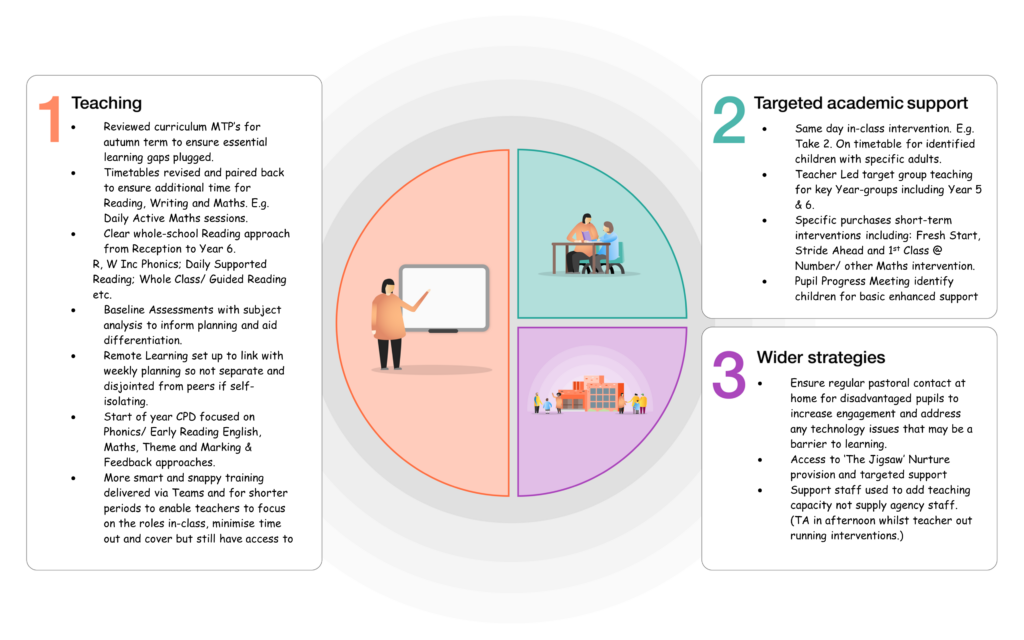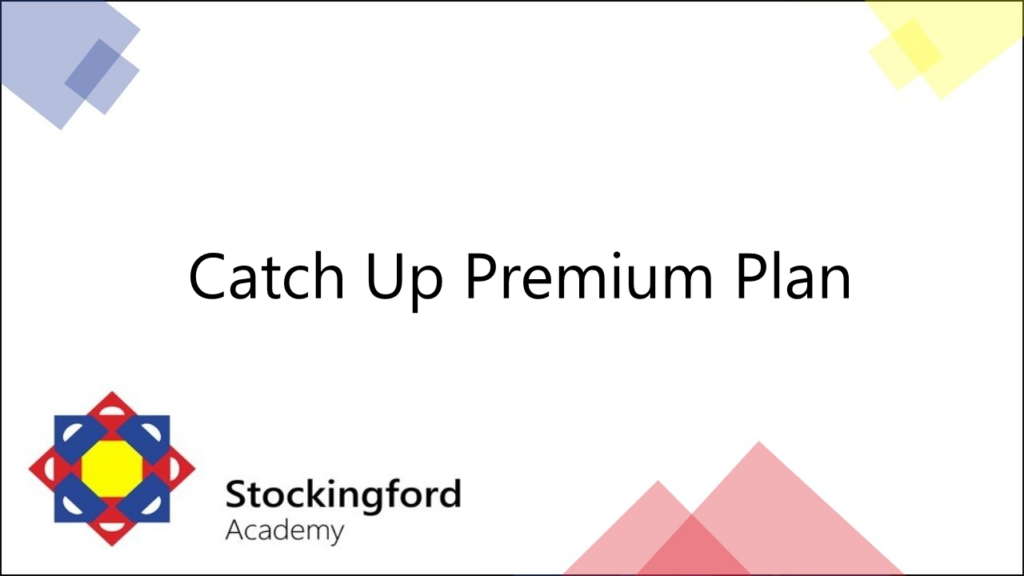Catch Up Premium
What catch-up funding is for?
In June 2020 the government announced £1 billion of funding to support children and young people to catch up on missed learning caused by coronavirus (COVID19). This is especially important for the most vulnerable pupils and pupils from disadvantaged backgrounds who we know have been most affected. This funding includes:
- a one-off universal £650 million catch-up premium for the 2020 to 2021 academic year to ensure that schools have the support they need to help all pupils make up for missed learning
- a £350 million National Tutoring Programme to provide additional, targeted support for those children and young people who need the most help, which includes:
- a school’s programme for 5 to 16-year-olds – for more information, see the National Tutoring Programme FAQs
- a 16 to 19 tuition fund
- an oral language intervention programme for reception-aged children
This guidance applies to the catch-up premium only.
Eligibility
The followings settings are eligible:
- primary, secondary and all through local authority-maintained schools, academies and free schools
- local authority-maintained special schools
- special academies and free schools
- special schools not maintained by a local authority
- pupil referral units
- alternative provision (AP) academies and free schools
- local authority-maintained hospital schools and academies
- independent special schools
We will provide funding to local authorities for pupils with education, health and care (EHC) plans who are educated in independent special schools based on the number of such pupils in their area.
Funding allocations
School allocations will be calculated on a per pupil basis.
Mainstream schools will get £80 for each pupil from reception to year 11 inclusive.
The following settings will get £240 for each place for the 2020 to 2021 academic year:
- special schools, including special units within mainstream schools
- AP schools
- hospital schools
We have applied additional weighting to specialist settings, recognising the significantly higher per pupil costs they face. A typical primary school of 200 pupils will receive £16,000 while a typical secondary school of 1,000 pupils will receive £80,000.
See the Coronavirus (COVID-19) catch-up premium: allocations guidance for further information.
Payment schedule
Schools will get funding in 3 tranches.
- Autumn 2020 – this is based on the latest available data on pupils in mainstream schools and high needs place numbers in special, AP, hospital schools and special schools not maintained by a local authority.
- Early 2021 – based on updated pupil and place data. This payment will also take account of the initial part payment made in autumn 2020 so that schools will receive a total of £46.67 per pupil or £140 per place across the first 2 payment rounds.
- Summer 2021 term – a further £33.33 per pupil or £100 per place.
See the Coronavirus (COVID-19) catch-up premium: allocations guidance for the latest payment information.
How funding allocations are calculated
For mainstream schools, we will use the 4 to 15 pupil headcounts from the October 2020 census. For special, AP and hospital schools, we will use:
- 2019 to 2020 academic year place numbers from the published local authority 2019 to 2020 financial year budget returns for local authority-maintained schools
- the published high needs place numbers for the 2020 to 2021 academic year for academies and special schools not maintained by a local authority
Similar to the pupil premium, schools should use the sum available to them as a single total even though funding is calculated on a per pupil or per place basis. Funding will only be available for the 2020 to 2021 academic year and will not be added to schools’ baselines in calculating future years’ funding allocations.
Using catch-up funding
Schools should use this funding for specific activities to support their pupils’ education recovery in line with the curriculum expectations in the actions for schools during the coronavirus outbreak guidance.
While schools can use their funding in a way that suits their cohort and circumstances, they are expected to use this funding for specific activities which will help pupils catch up on missed learning. Schools should particularly focus on disadvantaged and vulnerable pupils as we know they have been most affected.
To support schools to make the best use of this funding, the Education Endowment Foundation (EEF) has published a coronavirus (COVID-19) support guide for schools with evidence-based approaches to catch up for all students.
To support schools to implement their catch-up plans effectively, EEF has published the school planning guide: 2020 to 2021. This will provide further guidance on how schools should implement catch-up strategies and supporting case studies to highlight effective practice.
Schools can use catch-up premium funding to support any summer catch-up provision that they are offering and can carry funding forward to future academic years.
Accountability: school leaders and governors
School leaders must be able to show they are using the funding to support their pupils’ educational recovery in line with the curriculum expectations in the actions for schools during the coronavirus outbreak guidance.
Governors and trustees should scrutinise schools’ approaches to catch-up, including their plans for and use of catch-up funding. This should include consideration of whether schools are spending this funding in line with their catch-up priorities and ensuring appropriate transparency for parents.
Information is available on:
- what academies should publish online about their use of catch-up premium funding
- what maintained schools should publish online about their catch-up premium funding
Monitoring by Ofsted
It is intended that Ofsted will resume its full programme of routine, graded school inspections in September 2021.
During the summer term, Ofsted intends to restart some onsite inspections under its education inspection framework. The inspections are due to start from 4 May. Details of the inspection plans are available at Ofsted: coronavirus (COVID-19) rolling update. As part of these inspections, inspectors may discuss plans schools have to spend their catch-up premium funding.



